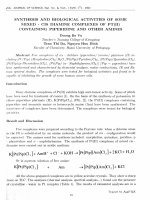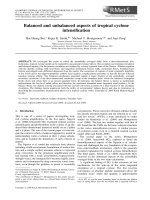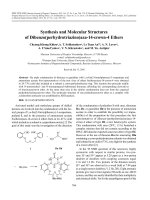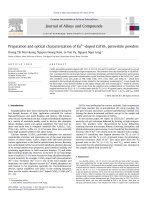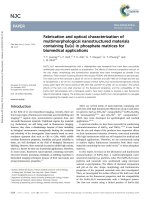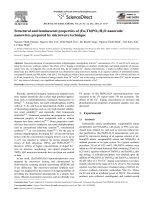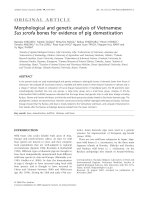DSpace at VNU: Preparation and magneto-caloric effect of La1-xAgxMnO3 (x=0.10-0.30) perovskite compounds
Bạn đang xem bản rút gọn của tài liệu. Xem và tải ngay bản đầy đủ của tài liệu tại đây (326.42 KB, 6 trang )
Physica B 319 (2002) 168–173
Preparation and magneto-caloric effect of La1ÀxAgxMnO3
(x=0.10–0.30) perovskite compounds
Nguyen The Hiena,b,*, Nguyen Phu Thuya,b
a
Cryogenic Laboratory, College of Natural Science, Faculty of Physics, Vietnam National University, 334 Nguyen Trai Road,
Thanh Xuan, Thoung Dinh, Hanoi, Viet Nam
b
International Training Institute for Materials Science (ITIMS), The ITIMS Building, DHBK, 1 Dai Co Viet Road,
Hanoi, Viet Nam
Received 16 February 2002; received in revised form 16 March 2002
Abstract
Polycrystalline La1ÀxAgxMnO3 perovskite compounds (with x=0.10–0.30) have been synthesised by both the
conventional solid-state reaction and the sol–gel method. While all samples with Ag concentrations up to 0.20 consist of
single-phase perovskites with rhombohedral structure, unreacted Ag was found in the samples with Ag concentrations
of 0.22 and higher. Magnetic properties of the as-prepared materials have been investigated. The magneto-caloric effect
in these compounds has been found to be considerably large and higher than that in other perovskite compounds in
which La is substituted by divalent alkali-earth elements. r 2002 Elsevier Science B.V. All rights reserved.
Keywords: Magneto-caloric effect; La1ÀxAgxMnO3; Perovskite compounds
1. Introduction
The lanthanum-based manganite and cobaltate
perovskite compounds, such as La1ÀxAxMnO3,
La1ÀxAxCoO3 with A=Ca, Sr and Ba, etc. have
shown a variety of interesting electrical, electronic
and magnetic properties that have great potentials
for application. Due to their colossal magnetoresistance (CMR) effect, these materials have been
considered as promising candidates for magnetic
sensor, magneto-resistive memory and recording
applications, etc. They have attracted, therefore,
much research work in the last few years [1–3].
Recent investigations have revealed that replacing
*Corresponding author. Fax: +84-4-858-4438.
E-mail address: (N.T. Hien).
the divalent alkali-earth metals by monovalent
elements, such as Na, K and Li, also leads to
similar phenomena in these compounds [4–6].
Since the success in the fabrication of a
continuously working demonstration magnetic refrigerator [7] and the discovery of the giant magneto-caloric effect (MCE) in the Gd5(Ge1ÀxSix)4
compounds (with 0pxp0.5) [8], there is a
growing interest concerning the MCE and magnetic refrigeration. Investigations are now focussed
on new materials with high MCE at high (close to
room) temperatures to be used as magnetic
refrigerants [9]. It has been shown that the
perovskite compounds with lanthanum and divalent alkali-earth elements also exhibit a large MCE
and, therefore, they can be considered as potential
candidates for application as refrigerants in
0921-4526/02/$ - see front matter r 2002 Elsevier Science B.V. All rights reserved.
PII: S 0 9 2 1 - 4 5 2 6 ( 0 2 ) 0 1 1 1 8 - 3
N.T. Hien, N.P. Thuy / Physica B 319 (2002) 168–173
Samples of La1ÀxAgxMnO3 were prepared by
both the conventional solid-state reaction (with
x ¼ 0:10; 0.13, 0.15, 0.17, 0.20, 0.22, 0.25, 0.27
and 0.30) and the sol–gel method (with x ¼ 0:10;
0.15, 0.20, 0.25 and 0.30). For the conventional
solid-state reaction samples, powders of La2O3 of
3N purity, AgNO3 or Ag2O (4N) and MnO2
(4N) were two times manually ground, mixed, pelletised and fired at 8501C for 10–20 h. Finally, the
prefired pellets were reground, pressed again
and sintered at 9501C for 48 h. For the sol–
gel samples, solutions of lanthanum nitrate hydrate La(NO3)2 Á 6H2O (4N), AgNO3 (4N),
Mn(CH3COO)2 (4N), C6H8O7 Á 2H2O (4N),
CH3COOH (4N) and NH4OH (4N) as starting
chemicals were mixed in the nominal compositional ratio of the cations. The xerogels obtained
from the procedure were dried at 801C and heated
at 650–7001C for about 2–5 h. As-prepared samples were examined by X-ray diffraction (XRD)
and by electron microscopy as well.
Magnetisation as a function of the temperature
was measured in a vibrating sample magnetometer
(VSM) for the temperature range from 100 to
350 K in applied fields up to 1 mT. From the data,
the Curie temperatures of the paramagnetic to
ferromagnetic phase transition were deduced.
Magnetisation curves were measured in applied
fields up to 8 T, at various temperatures around
the Curie point, in the pulsed-field magnetometer
(PFM) at the International Training Institute for
Materials Science (ITIMS) [14]. From these
magnetisation curves, the MCE, i.e., the magnetic-entropy change –DSmag due to the change of
3. Results and discussion
In Fig. 1, we show the XRD patterns for some
La1ÀxAgxMnO3 samples as representatives for the
two series of compounds prepared by the sol–gel
(a) and by the solid-state reaction method (b). As
can be noted in Fig. 1a, the patterns for the three
sol–gel samples with xp0:20 consist of reflections
typical for single-phase La1ÀxAgxMnO3 perovskite compounds with rhombohedral structure, in
agreement with the results reported by Tang et al.
[13] for their solid-state reaction (sintered) samples
of similar compositions. In the patterns for
sintered samples with xX0:22; however, additional
peaks occur at 2y ¼ 381; 44.51 and 64.51, which
can be identified as due to the presence of metallic
silver in the samples. As it is clearly seen in Fig. 2b,
Intensity (arb.units)
2. Experimental
the applied fields DB; have been determined for all
samples investigated, using the same procedure
described previously [15].
x =0.20
x =0.15
x =0.10
(a) 20
Intensity (arb.units)
magnetic refrigeration, especially with respect to
the material costs [10–12]. Recent magneto-caloric
investigations have also revealed considerable
MCE in the lanthanum manganites where monovalent elements instead of divalent alkali-earth
metals are substituted for La [4,5,13]. In the
present paper, we report on the solid-state reaction and sol–gel preparation, and the MCE in
La1ÀxAgxMnO3 perovskite compounds with x ¼
0:1020:30:
169
30
40
50
70
60
80
x =0.13
x=0.20
x =0.22
x =0.27
20
(b)
30
40
50
2 (degree)
60
70
Fig. 1. XRD patterns for some La1ÀxAgxMnO3 samples prepared by the sol–gel (a) and the solid-state reaction method (b).
N.T. Hien, N.P. Thuy / Physica B 319 (2002) 168–173
170
the intensity of these additional peak increases in
our corresponding sintered samples with increasing Ag concentration. We note that the solid-state
reaction samples were sintered at 9501C for 48 h
whereas the sol–gel samples were heated at 7001C
for 5 h only. We have found that even in the low
Ag-concentration region, heating the xerogels at
lower temperature and shorter time, and/or
sintering the solid-state reaction samples at temperatures above 9501C for even longer time, both
leads to inclusions of pure Ag in the samples.
Scanning and transmission electron microscopy (SEM and TEM) experiments (not shown
here) were carried out to check the grain structure
of the as-prepared samples. The SEM photographs showed that the grains in the sintered
samples reach sizes in the order of microns,
whereas TEM experiments on a sol–gel sample of
La0.90Ag0.10MnO3 revealed grain sizes of about
Magnetisation (A.m2/kg)
1.2
1.0
0.8
0.6
La 0.80Ag 0.20MnO 3
0.4
FC
0.2
0.0
ZFC
100
(a)
200
300
Temperature (K)
400
Magnetisation (A.m2/kg)
1.2
(b)
FC
1.0
0.8
0.6
ZF C
La 0.83Ag 0.17MnO 3
0.4
0.2
0
100 130 160 190 220 250 280 310 340
Temperature (K)
Fig. 2. (a) Magnetisation of the La0.80Ag0.20MnO3 sol–gel sample in the temperature range from 100 to 360 K in an applied
field of 2.5 mT. (b) Magnetisation of the La0.83Ag0.17MnO3
sintered sample in the temperature range from 100 to 350 K in
an applied field of 10 mT.
50 nm. The presence of small amounts of pure
metallic silver in the high Ag-concentration
sintered samples is also indicated by another
SEM analysis [16].
Using both aforementioned preparation methods, however, we have not succeeded to fabricate a
single-phase sample of the compound with x ¼
0:30: We note that Tang et al. [13] have reported
the presence of unreacted metallic Ag, other
precursor oxides and LaMnO3 in sintered samples
with xX0:25:
As an example for the compounds prepared by
the sol–gel method, Fig. 2a shows the magnetisation of the La0.80Ag0.20MnO3 sample as a function
of temperature, measured on a VSM in a field
of 2.5 mT for the temperature region from 100
to 360 K, in both field-cooled and zero fieldcooled modes. The curves obtained are denoted
by MðTÞFC and MðTÞZFC ; respectively. Both
MðTÞFC and MðTÞZFC curves show a sharp phase
transition of the sample at about 305 K from the
paramagnetic to the ferromagnetic state. There is
another phase transition at about 160 K obvious,
which is probably related to the so-called reentrant
magnetic phase transition. The distinct separation
between the MðTÞFC and MðTÞZFC curves in the
temperature range below the Curie point suggests
a spin-glass- or cluster-class-like behaviour often
observed in this type of compounds [2]. For
comparison, we show in Fig. 2b, the magnetisation
of the La0.83Ag0.17MnO3 sample, prepared by the
solid-state reaction method, in the temperature
range from 100 to 350 K measured on a VSM in
10 mT in both the field-cooled and the zero fieldcooled mode. Also here, the compound shows a
spin-glass-like behaviour at low temperatures and
a sharp phase transition at about 290 K from the
paramagnetic to the ferromagnetic state. Such a
significant reduction of the magnetisation at low
temperature as observed in the sol–gel sample,
however, does not appear in the sintered type of
samples. Moreover, the MðTÞZFC curve reveals a
lower transition temperature than the MðTÞFC
one. Further investigations are under way to
elaborate the origin of the above-mentioned
phenomena.
In Figs. 3a and b, we show the magnetisation as
a function of the applied field measured in the
N.T. Hien, N.P. Thuy / Physica B 319 (2002) 168–173
PFM at various temperatures around the Curie
point, on two La0.80Ag0.20MnO3 samples prepared
by the two different methods, again as representatives for the series of compounds investigated.
While the sintered sample clearly exhibits a
saturated ferromagnetic state just below the Curie
point, which can be observed in the behaviour of
the MðBÞ curves in Fig. 3b, the magnetisation
MðBÞ curves for the La0.80Ag0.20MnO3 sol–gel
sample in Fig. 3a at temperatures far below the
Curie point do not show any tendency of saturation even in applied fields as high as 8 T. This can
be due to the competition between the antiferroand the ferromagnetic phases and/or a superparamagnetic behaviour of the nanosized particles
in this sample. Actually, as mentioned above, we
have observed grain sizes in the order of about
50 nm in a La0.90Ag0.10MnO3 sol–gel sample,
which was prepared by the same procedure as
the one used in this measurement.
230 K
240 K
250 K
260 K
50
270 K
40
280 K
290 K
30
300 K
20
Fig. 4. Entropy change as a function of the temperature at
different field variations for the La0.78Ag0.22MnO3 sintered
sample.
La 0.80 Ag0.20 MnO3
Sol-gel sample
10
0
0
1
2
(a)
3
4
5
6
7
8
9
Field (T)
80
Magnetisation (A.m2/kg)
210K
220K
235K
245K
255K
260K
265K
270K
275K
280K
285K
290K
295K
300K
305K
310K
La 0.80 Ag0.20 MnO3
70
60
50
40
30
20
10
0
0
(b)
From these magnetisation curves we derived
the magnetic-entropy change ÀDSmag caused by
the variation of the applied field as the MCE for
the samples. Results shown in Fig. 4 present the
magnitude of the MCE for the La0.78Ag0.22MnO3
sintered sample at different field variations (from
zero field up to the indicated value DB). It is clearly
seen that for DB ¼ 1 T; the magnetic-entropy
change at the Curie temperature in this sample
reaches a value of about 2.9 J/kg K, and about
7.8 J/kg K for DB ¼ 3 T: In Fig. 5, we show the
entropy change as a function of temperature, at a
field variation of DB ¼ 1 T for three sintered
samples with x ¼ 0:17; 0.20 and 0.22. We note
0.5
1
1.5
2
2.5
3
3.5
3
La0.83Ag0.17MnO3
2.5
-∆
∆ Smag (J/kg . K)
Magnetisation (A.m2/kg)
60
171
2
La0.80Ag0.20MnO3
La0.78Ag0.22MnO3
1.5
1
0.5
Field (T)
Fig. 3. (a) Isothermal magnetisation curves for the
La0.80Ag0.20MnO3 sol–gel sample measured at different temperatures from 230 to 300 K. (b) Isothermal magnetisation
curves for the La0.80Ag0.20MnO3 sintered sample measured at
different temperatures from 210 to 310 K.
0
260
270
290
280
T (K)
300
310
Fig. 5. Entropy change at a field variation of 1 T, as a function
of temperature, for La1ÀxAgxMnO3 sintered samples.
172
N.T. Hien, N.P. Thuy / Physica B 319 (2002) 168–173
that our sample with x ¼ 0:22 shows the highest
MCE.
The Curie temperature TC and the maximum
magnetic-entropy change ÀDSmag at DB ¼ 1 T as a
function of the Ag content is summarised in Fig. 6.
As we can see, the Curie temperature of the sol–gel
samples increases rapidly from 150 (for x=0.10) to
around 300 K for x ¼ 0:15; and becomes almost
saturated at about 310 K for Ag concentrations of
xX0:20: For the sintered samples, TC increases
more gradually from 250 K for x ¼ 0:10; via 280 K
for x ¼ 0:13; 290 K for x ¼ 0:17; to 300 K for x ¼
0:20 and finally to a saturated value of about
306 K for x > 0:20: These values are compared
with those reported by Tang et al. [13] for their
solid-state reaction samples of corresponding
composition, i.e. 214, 278, 306 and 306 K for x ¼
0:05; 0.20, 0.25 and 0.30, respectively. The values
of TC for the sintered solid-state reaction samples
are somewhat lower than those for the sol–gel
samples of the corresponding compositions. This
might be caused by the lower actual Ag concentration, as can be inferred from the XRD
experiments, due to the presence of small amounts
of unreacted metallic Ag in the samples. In this
figure, we can also see that the MCE in the sol–gel
samples is somewhat lower than that in the
sintered ones. This can be ascribed to the fact
that the sol–gel samples were heated at 7001C for
5 h only. Under these conditions, the single-phase
La1ÀxAgxMnO3 compounds have been fully
formed, but the grains have not been so far
developed as in the sintered samples. The MCE in
our sintered samples reaches a maximum value of
2.9 J/kg K at x ¼ 0:22: This value is, however,
somewhat lower than a maximum value of 3.4 J/
kg K reported by Tang et al. [13] for their x ¼ 0:20
sample. Even so, this is significantly higher than,
for instance, 2.4 J/kg K in the perovskite compound of La0.60Ca0.40MnO3 [11]. It is thus, worth
to note that for the same field variation, the MCE
at the Curie temperature in the La1ÀxAgxMnO3
system is remarkably higher than in the perovskite
compounds with lanthanum and divalent alkaliearth metals. Hysteresis loop measurements (not
shown here) yielded coercivities as low as 1 mT,
similar to the values reported by Tang et al. [13].
This revealed the materials to be of soft ferromagnetic type and, in this respect, also suitable for
room temperature magnetic-refrigeration application.
In conclusion, we have prepared samples of
La1ÀxAgxMnO3 perovskite compounds (with
x¼ 0:1020:30) by both the sol–gel and solid-state
reaction methods. While single-phase materials of
the rhombohedral perovskite compounds have
been obtained for Ag concentrations up to x ¼
0:20; in the samples with xX0:25 small amounts of
metallic Ag are still present. The materials as
obtained show significant MCE at Curie temperatures as high as 310 K, along with other interesting
magnetic properties, and can be considered as a
promising potential candidate for the application
as magnetic refrigerants in room temperature
magnetic refrigeration.
Acknowledgements
Fig. 6. The Curie temperature (right scale) and the entropy
change (left scale) as a function of the silver concentrations in
the La1ÀxAgxMnO3 system.
This paper is dedicated to Prof. Dr. J.J.M.
Franse from the University of Amsterdam who
will celebrate his 65th anniversary these days. The
authors are grateful to him who, in his long
standing scientific co-operation with Vietnam, has
given a lot of stimulation and inspiration on the
development of the high-pulsed-field magnetometer at ITIMS, and of the research activities
on superconducting cuprates at the Cryogenic
N.T. Hien, N.P. Thuy / Physica B 319 (2002) 168–173
Laboratory. The work described here is actually a
follow up of such developments.
This work is part of the research project QGTD00-01 granted by the Vietnam National University
(VNU), Hanoi, and partly supported by the State
Programme in Fundamental Research of Vietnam.
Furthermore, the authors would like to express
their sincere thank to their colleagues: Mr. Pham
Van Tong from the Cryogenic Laboratory, Dr. Le
Van Vu and Mr. Phung Quoc Thanh from the
Centre for Materials Science (CMS), Faculty of
Physics, College of Natural Science, VNU Hanoi;
Dr. Tran Quang Vinh and Mr. Ngo Van Nong
from ITIMS, and Prof. Nguyen Hanh from the
Faculty of Chemical Technology, Hanoi University of Technology, for their close co-operation
and fruitful discussions.
References
[1] R. Mahendiran, S.K. Tiwary, A.K. Raychaudhuri, T.V.
Ramakrishnan, R. Mahesh, N. Rangavittal, C.N.R. Rao,
Phys. Rev. B 53 (1996) 3348.
[2] A.P. Ramirez, J. Phys.: Condens. Matter 9 (1997) 8171 and
references therein.
[3] X.L. Wang, S.X. Dou, H.K. Liu, M. Lonescu, B. Zeimetz,
Appl. Phys. Lett. 73 (1998) 396.
[4] W. Zhong, W. Chen, W.P. Ding, N. Zhang, Y.W. Du,
Q.J. Yan, Solid State Commun. 106 (1998) 55.
[5] M. Ito, T. Shimura, J.-D. Yu, T. Hayashi, Y. Inaguma,
Phys. Rev. B 52 (1995) 12522.
!
[6] L.E. Hueso, J. Rivas, F. Rivadulla, M.A. Lopez-Quintela,
J. Appl. Phys. 89 (2001) 1746.
173
[7] C. Zimm, A. Jastrab, A. Sternberg, V. Pecharsky, K.
Gschneidner Jr., M. Osborne, I. Anderson, Adv. Cryog.
Eng. 43 (1998) 1759.
[8] V.K. Pecharsky, K.A. Gschneidner Jr., Phys. Rev. Lett. 78
(1997) 4494;
V.K. Pecharsky, K.A. Gschneidner Jr., Appl. Phys. Lett.
70 (1997) 3299;
V.K. Pecharsky, K.A. Gschneidner Jr., J. Magn. Magn.
Mater. 167 (1997) L179;
V.K. Pecharsky, K.A. Gschneidner Jr., J. Alloys Compounds 260 (1997) 107.
[9] A.M. Tishin, in: K.H.J. Buschow (Ed.), Handbook of
Magnetic Materials, Vol. 12, North-Holland, Amsterdam,
1999, pp. 395;
V.K. Pecharsky, K.A. Gschneidner Jr., J. Magn. Magn.
Mater. 200 (1999) 44.
[10] Z.B. Guo, J.R. Zang, H. Huang, W.P. Ding, Y.W. Du,
Appl. Phys. Lett. 70 (1997) 904;
Z.B. Guo, J.R. Zang, Y.W. Du, J.S. Zhu, H. Huang,
W.P. Ding, D. Feng, Phys. Rev. Lett. 78 (1997) 1142.
[11] X. Bogihas, J. Tejada, M.L. Marinez-Sarron, S. Tripp,
R. Black, J. Magn. Magn. Mater. 208 (2000) 85.
[12] S. Chaudhary, V.S. Kumar, S.B. Roy, P. Chaddah,
S.R. Krishnakumar, V.G. Sathe, A. Kuma, D.D. Sarna,
J. Magn. Magn. Mater. 202 (2000) 47.
[13] T. Tang, K.M. Gu, Q.Q. Cao, D.H. Wang, S.Y. Zhang,
Y.W. Du, J. Magn. Magn. Mater. 222 (2001) 110.
[14] C.V. Thang, T.Q. Vinh, N.P. Thuy, J.J.M. Franse, Physica
B, A 246–247, 505.
[15] T.Q. Vinh, N.T. Hien, N.V. Nong, N.T. Long, L.T. Tai,
N.P. Thuy, P.D. Thang, E. Bruck,
.
H.G.M. Duijn, Trends
in materials science, Proceedings of the Third International
Workshop on Materials Science (IWOMS ‘99), Part II,
Hanoi, Vietnam, November 2–4, 1999, VNU Printing
House, Hanoi, p. 258, ISBN–90-5776-033-9.
.
[16] I. Baecher, K. Wetzig, Institut fur
. Festkorperanalytik
und
Strukturforschung (IFS) im IFW Dresden, Germany,
private communications.

